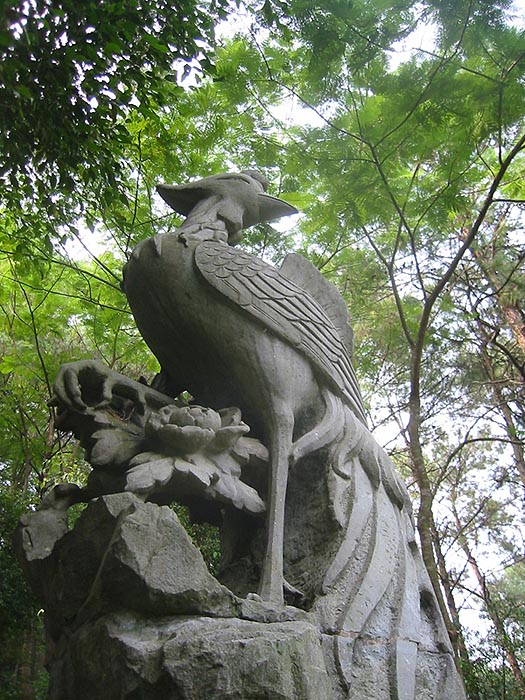Intrepid journalist Hank Talbot continues his exposé of the disturbing political agenda behind the zoo world facebook propaganda blitz.
I believe we’ve sufficiently covered the history of the taijitu symbol (and it’s anachronistic Roman cousin), a graphic representation of the taoist yin and yang concept. The word taijitu translates literally, albeit somewhat awkwardly, to “diagram of the supreme ultimate.” Most folks have a solid understanding of the word “diagram,” but the usage of “supreme” and “ultimate” in Western culture creates something of an East/West split regarding these words.
pulchritudinous pandas
how to sustain your dragon
part 5
Regarding part four, the observation has been made that a dactylographic monkey might have done a better job of getting to the point and getting back to the zoo world ad this is suppost to be about. However exaggerated that criticism might be, the point is well-taken. Let’s get back on track.
I believe we’ve sufficiently covered the history of the taijitu symbol (and it’s anachronistic Roman cousin), a graphic representation of the taoist yin and yang concept. The word taijitu translates literally, albeit somewhat awkwardly, to “diagram of the supreme ultimate.” Most folks have a solid understanding of the word “diagram,” but the usage of “supreme” and “ultimate” in Western culture creates something of an East/West split regarding these words.
Supreme
“Supreme” shows up in our judicial system, our motown, and our fast food.
Ultimate
“Ultimate” shows up in our electronics, our fighting, and our Frisbee®.
In fact, the sport of Ultimate Frisbee® is officially referred to as “Ultimate.” This change brought to you courtesy of the folks in the legal department at Wham-O, Inc., whose favourite game appears to be trademark enforcement. So, even if you and your friends are using a Classic™ Frisbee®, you’re still playing “Ultimate.” As it turns out, most die-hard aficionados kind of like calling their sport “Ultimate” because it sounds more badass. Take that, Wham-O!
Ultimate Supreme
Further confusion stems from the common appearance of the “Ultimate” [Frisbee®] shape in the domain of the supreme.
Especially in light of this last example, it is not difficult to see how western cultural connotations might adversely impact our ability to properly appreciate the diagram of the supreme ultimate—the taijitu.
Therefore, my dear reader, be not ashamed if you have embraced the common misconception that the white and black colours of the taijitu represent good and evil. This misinterpretation is a product of our binary western paradigm—but we must resist the urge to project a black-and-white sort of morality onto this symbol. Rather, consider it in light of the law of the unity of opposites: light and dark, male and female, yin and yang. Then you will see how a devoted follower of Mao can simultaneously appreciate a pesky population of reactionaries and a nice set of bristols.
Dragons are from Mars, Fenghuangs are from Venus
The yin and the yang have specific symbolism, outlined nicely in this excerpt:
The relationship between yin and yang is often described in terms of sunlight playing over a mountain and in the valley. Yin (literally the ‘shady place’ or ‘north slope’) is the dark area occluded by the mountain’s bulk, while yang (literally the ‘sunny place’ or ‘south slope’) is the brightly lit portion. As the sun moves across the sky, yin and yang gradually trade places with each other, revealing what was obscured and obscuring what was revealed.
More specifically, yin and yang are divvied up as follows:
yin |
• |
yang |
|---|---|---|
| slow | fast | |
| soft | hard | |
| insubstantial | solid | |
| diffuse | focused | |
| cold | hot | |
| wet | dry | |
| tranquil | aggressive | |
| nighttime | daytime | |
| femininity | masculinity | |
| fenghuang | dragon |
The fenghuang, of course, is the mythological bird-ruler of East Asia. This avian monarch rules over all the other birds, and is sometimes referred to as the Chinese phoenix. Within the fenghuang species, there is a yin-yang gender division (feng is male, huang is female); however, the fenghuang species as a whole is considered a feminine entity. It is the yin to the Chinese dragon’s yang.
Like most females, the fenghuang is a complicated creature. I was going to try to diagram it for you, but instead decided to simply include the bird’s description.
According to scripture Erya – chapter 17 Shiniao, Fenghuang is said to be made up of the beak of a rooster, the face of a swallow, the forehead of a fowl, the neck of a snake, the breast of a goose, the back of a tortoise, the hindquarters of a stag and the tail of a fish. Today, however, it is often described as a composite of many birds including the head of a golden pheasant, the body of a mandarin duck, the tail of a peacock, the legs of a crane, the mouth of a parrot, and the wings of a swallow.
Honestly, I’m not sure I can picture how all that holds together.
Nor can I make out all those parts in the fenghuang renderings I’ve come across.
Its body symbolizes the six celestial bodies. The head is the sky, the eyes are the sun, the back is the moon, the wings are the wind, the feet are the earth, and the tail is the planets. Its feathers contain the five fundamental colors: black, white, red, blue and yellow. It is also sometimes depicted as having three legs.
Sadly, I was unable to find a picture of a three-legged fenghuang. As it turns out, they are a bit camera-shy.
Perhaps we’ll discuss the fenghuang in more detail later, but for now, note that: (1) it is the female counterpart to the Chinese dragon, and (2) it always appears bare-breasted.
More to come . . .








